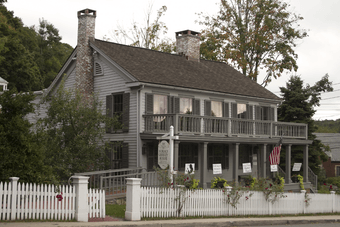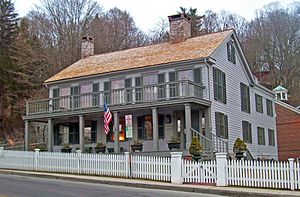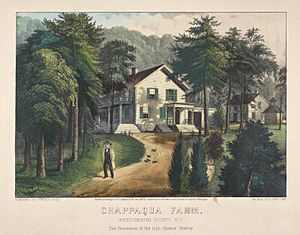Greeley House (Chappaqua, New York) facts for kids
Quick facts for kids |
|
|
Greeley House
|
|

East profile and north (front) elevation, 2012
|
|
| Location | Chappaqua, NY |
|---|---|
| Area | 0.3 acres (1,200 m2) |
| Built | 1864 |
| MPS | Horace Greeley TR |
| NRHP reference No. | 79003212 |
| Added to NRHP | April 19, 1979 |
The Greeley House is a historic home in Chappaqua, New York. It was built around 1820. This house was once the home of Horace Greeley, a famous newspaper editor. He lived here from 1864 until he passed away in 1872.
Greeley was also a candidate for president of the United States. In 1979, the Greeley House was added to the National Register of Historic Places. This is a list of important historical sites in the U.S. Several other places connected to Greeley are also on this list.
The house started as a small farmhouse in the 1820s. It was made bigger in the mid-1800s. Horace Greeley, who edited the New-York Tribune newspaper, moved to Chappaqua before the American Civil War. He and his family mostly stayed there during the summer.
Greeley was against slavery, and his newspaper often wrote about it. Because of his strong views, a group of people once threatened his family's first home. So, Greeley bought this farmhouse. It was safer and closer to his 100-acre farm. On his farm, he tried out new ways of growing crops.
After the Civil War, Greeley built a new, larger home called "Hillside House." But he and his wife passed away soon after the 1872 United States presidential election. Greeley had run for president against Ulysses S. Grant that year. His children then lived in Hillside House. Both of Greeley's other homes later burned down. This makes the Greeley House the only one still standing today.
In the early 1900s, the Greeley House was almost torn down because it was in bad shape. But it was saved and fixed up in 1940. After that, it was used as a restaurant and a gift shop. In the early 2000s, it was restored again. Now, it is the office for the New Castle Historical Society.
Contents
About the Greeley House Building
The Greeley House sits on a small piece of land, about one-third of an acre. It is at the corner of King and Senter streets in downtown Chappaqua. This area is part of the town of New Castle, New York. The Saw Mill River and a train line are a short distance to the west.
Around the house, you'll find different types of buildings. To the west are shops and parking lots. To the north and east, there's a church and newer homes. The local fire station is to the southeast. Across Senter Street, there's a community center and baseball fields.
What the House Looks Like
A white wooden picket fence with a gate surrounds the house. The house itself is made of wood and has two stories. It sits on a brick foundation and has a shingled roof. Two brick chimneys stick out from the roof. A two-story flat-roofed section extends from the back of the house.
On the front (north) side, there's a two-story porch that runs the whole width of the house. Wooden steps lead up to it from one side. There's also a brick wheelchair ramp for easy access. Square wooden pillars hold up the second-floor balcony. The main front door is on the west side. It has glass panels on either side.
The windows have six-over-six panes and are protected by storm glass. They have simple wooden sills and frames. The windows on the first floor are smaller. All windows have wooden shutters with slats. At the top of the east side of the roof, there are two small, half-moon-shaped windows. The roof has a simple decorative trim.
Inside the House
Inside, the house has a traditional layout. The front room was once the parlor, used for guests. The dining room was in the back. The kitchen, with a small storage area, is also in the back. There's a small music room on the north side.
Stairs lead up to the second floor. Above the storage area is a small bedroom, which was likely for a maid. Two larger bedrooms make up the rest of the second floor.
History of the Greeley House
The Greeley House has a long history, going through four main periods. It started as a simple farmhouse around 1820. Horace Greeley made it bigger when he moved in. After he passed away, his daughters kept the house. But they mostly lived elsewhere. The house was almost torn down in the mid-1900s but has been restored twice since then.
Early Years: Before the Greeleys (1820–1853)
A farmer named Haviland built the house around 1820. It was a typical farmhouse for the time and place. The main part of Chappaqua back then was about a mile away. That area was centered around the Quaker meetinghouse, which was built by the town's first settlers. This old area is now known as the Old Chappaqua Historic District.
In the mid-1800s, the New York and Harlem Railroad was built nearby. This train line connected Chappaqua to New York City. This changed Chappaqua in two ways. Farmers could now easily send their crops to the city markets. Also, the train station area slowly became the new center of town life.
Horace Greeley and His Farm (1853–1872)
The railroad also brought city people to Chappaqua. In the early 1850s, the Haviland house was made larger. It also got a new porch and balcony, along with decorative details. In 1853, Horace Greeley, the editor of the New-York Tribune, bought land nearby. He eventually owned 78 acres. He used this land as an experimental farm. He tested new farming methods and wrote about them in his newspaper columns. Even though some people made fun of him, much of his advice was actually helpful.
Greeley first planned for the farm to be a summer home. His wife, Mary, wanted a place with a spring, a forest, and to be near the train. Their Chappaqua property fit most of these wishes. To enjoy the countryside more, Greeley built another house called the "House in the Woods." But his wife found it too dark and far away.
During the American Civil War, Greeley continued to speak out against slavery in his newspaper. A group of angry people once threatened his "House in the Woods." In 1864, he bought the Haviland house (the Greeley House) because it was in a more open, visible spot. The Greeleys continued to expand this house, adding a music room. They still only lived there in the summers. Greeley himself could only visit on weekends because of his busy job.
After the war, Greeley kept farming and trying new methods. In 1870, he had so many apples that he made more apple cider than he could sell! Later that year, he built the first concrete barn in the country on his farm. This barn was later turned into a house called Rehoboth, which is also on the National Register.
Greeley started building a new family home, Hillside House, in 1870. It was finished in 1872. But before he could move in, he was chosen to run for president against Ulysses S. Grant. He held a big picnic on his farm to celebrate. Sadly, his wife Mary passed away a few days before the election. Greeley lost the election, and these events affected his health. He passed away a few weeks later. This was the only time a major presidential candidate has died before all the votes were counted.
Greeley's Daughters and the Town's Growth (1873–1926)
After their parents passed away, Greeley's two daughters, Ida and Gabrielle, returned to Chappaqua in the summer of 1873. They loved the house and its mix of city comforts and country peace. Their life there showed the start of a suburban lifestyle. This way of living, where people lived in the country but worked in the city, became very popular in Westchester County.
In 1875, the "House in the Woods" burned down. In 1890, Hillside House also burned down. This left the old farmhouse (the Greeley House) as the only one of Horace Greeley's three Chappaqua homes still standing.
In the early 1900s, Greeley's daughter Gabrielle and her husband began selling parts of the farm. The old train station was too small for the growing community. Gabrielle donated land for a new station, which opened in 1902. She also asked that the area in front of it be a park to honor her father.
In 1906, Gabrielle built a memorial chapel, Saint Mary the Virgin, on the land where her father had held his campaign picnic. In 1914, a statue of Horace Greeley was placed in the park near the train station.
Restoration and Modern Use (1927–Present)
Gabrielle sold the Greeley House in 1926, ending 62 years of Greeley family ownership. The rest of the farm was sold to a developer the next year. It was then divided into the downtown area we see today. Chappaqua changed from a quiet country place to a modern suburb. People still enjoyed the natural surroundings but traveled daily to jobs in the city.
During the Great Depression in the 1930s, the house was neglected and fell apart. It was almost torn down in 1940. But two local residents saved it and had it restored. One of them, Gladys Capen Mills, lived upstairs and ran a gift shop downstairs. For a while, the kitchen was also a restaurant.
In 1959, a local family bought the house. They made the gift shop bigger to use the whole house. They also added the flat-roofed section to the back. They ran their business there until 1998. After they closed, the New Castle Historical Society bought the house. In the early 2000s, the house was restored again to look more like it did when Greeley lived there. It has been the society's offices ever since.
See also






